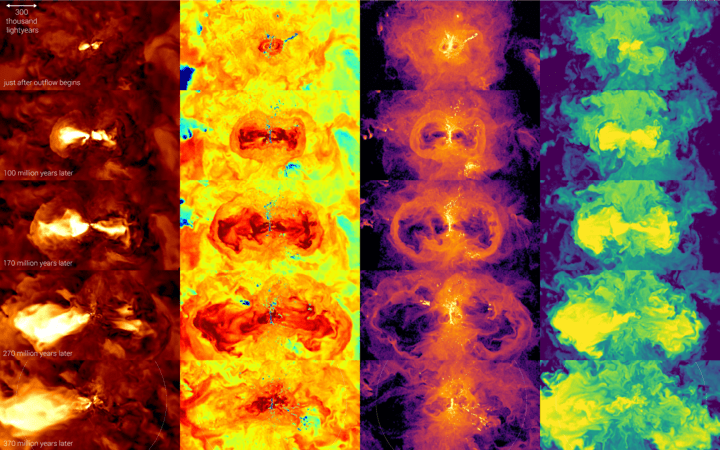
How did the universe evolve from a point of singularity, known as the Big Bang, into a massive structure whose boundaries seem limitless? New clues and insight into the evolution of the universe have recently been provided by an international team of physicists, who performed the most detailed large-scale simulation of the universe to date.
The researchers made their own universe in a box — a cube of space spanning more than 230 million light-years across. Previous cosmological simulations were either very detailed but spanned a small volume or less detailed across large volumes. The new simulation, known as TNG50, managed to combine the best of two worlds, producing a large-scale replica of the cosmos while, at the same time, allowing for unprecedented computational resolution.
The level of detail is incredible, matching what was once only possible to do in simulations of individual galaxies. TNG50, in fact, tracks 20 billion particles representing dark matter, stars, cosmic gas, magnetic fields, and supermassive black holes.
However, this kind of fine detail came at a cost. It took more than 16,000 cores on the Hazel Hen supercomputer in Stuttgart operating in tandem, non-stop for a year to perform the required calculations. For reference, it would have taken 15,000 years to complete the simulation on a single processor, making TNG50 one of the most computationally demanding astrophysical simulations to date.
In two recently published studies led by Annalisa Pillepich and Dylan Nelson, from the Max Planck Institute for Astronomy and Max Planck Institute for Astrophysics, respectively, the researchers shared their most important findings.
“Numerical experiments of this kind are particularly successful when you get out more than you put in. In our simulation, we see phenomena that had not been programmed explicitly into the simulation code. These phenomena emerge in a natural fashion, from the complex interplay of the basic physical ingredients of our model universe,” Nelson said in a statement.
One example of such emerging behavior if the formation of “disk” galaxies, like the Milky Way. While disk galaxies seem very ordered and flat, by rewinding their evolution, researchers could see that such structures emerge from chaotic and disorganized turbulent clouds of gas.
“In practice, TNG50 shows that our own Milky Way galaxy with its thin disk is at the height of galaxy fashion: over the past 10 billion years, at least those galaxies that are still forming new stars have become more and more disk-like, and their chaotic internal motions have decreased considerably. The Universe was much more messy when it was just a few billion years old!” Pillepich said in a statement.

Another emerging phenomenon captured by the simulation was represented by high-speed outflows and winds of gas emanating from galaxies. These outflows and winds are the result of supernovae and supermassive black hole activity.
These galactic outflows were initially chaotic — just like early galactic structures — but, over time, they became more focused on the paths of least resistance. In the modern universe, these winds slow down as they make their way away from the gravitational well of the dark matter halo, and can eventually stall and fall back onto their parent galaxies. The astronomers liken the process to a galactic fountain of recycled gas.
By this process, gas is redistributed from the center of the galaxy to its outskirts. In time, this contributes to the transformation of the galaxy into a thin disk. But this can also work both ways: galactic structures also shape galactic fountains.
In the future, the astronomers will release all the simulation’s data to the scientific community at large so that new discoveries might come out of the TNG50 universe.
The two studies will be published in the December 2019 issue of the Monthly Notices of the Royal Astronomical Society.


